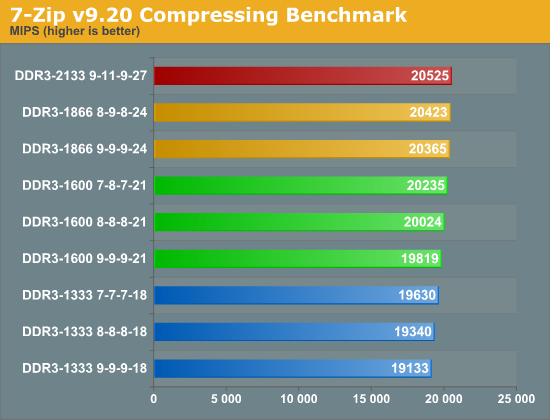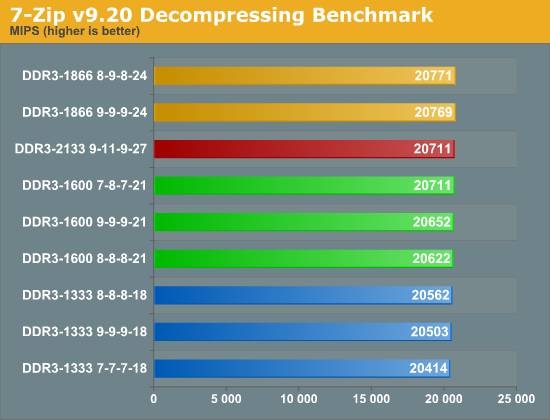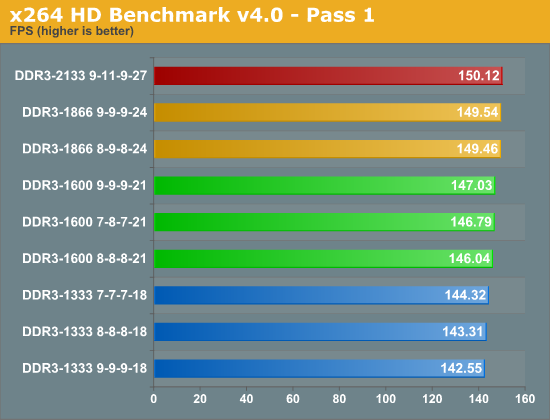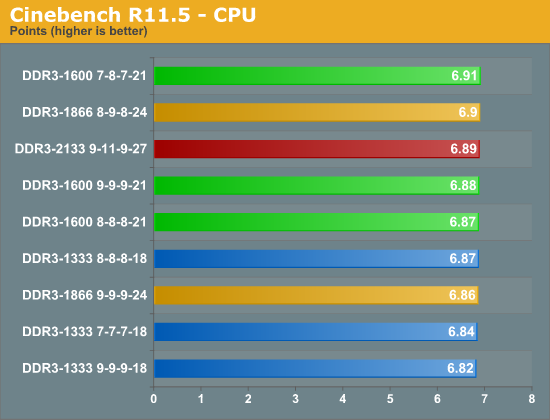Sandy Bridge Memory Scaling: Choosing the Best DDR3
by Jared Bell on July 25, 2011 1:55 AM EST7-Zip
Many people are moving over to 7-Zip for their compression/decompression needs. 7-Zip is not only free and open-source, but it also has a built in benchmark for measuring system performance using the LZMA compression/decompression method. Keep in mind that these tests are ran in memory and bypass any potential disk bottlenecks. The compression routines in particular can put a heavy load on the memory subsystem, as many MB worth of data is scanned for patterns that allow the compression to take place. In a sense, data compression is one of the best real-world tests for memory performance.


The compression test shows a linear performance increase with a ~7% variance between the fastest and slowest. If you do a fair amount of compressing, you could potentially save some time in the long run by using faster memory. This, of course, is assuming you're not bottlenecked elsewhere such as in your I/O or CPU performance. The decompression test isn’t affected by faster memory in the same way, as there’s no pattern recognition going on; it’s simply expanding the already found patterns into the original files. With less than 2% separating the range, it's unlikely to make much of a difference if you’re primarily decompressing files.
x264 HD Benchmark
The x264 HD Benchmark measures how fast your system can encode a short HD-quality video clip into a high quality H.264 video file. There are two separate passes performed and compared. Multiple passes are generally used to ensure the highest quality video output, and the first pass tends to be more I/O bound while the second pass is typically constrained by CPU performance.


While not a huge spread, we do see a difference of 5% from the fastest to the slowest in the first pass. The second pass, however, shows a less than 2% gain. If encoding is one of your systems primary tasks, it's possible that having faster memory could pay off over time, but a faster CPU will be far more beneficial.
Cinebench 11.5
The Cinebench CPU test scenario uses all of your system's processing power to render a photorealistic 3D scene containing approximately 2,000 objects and nearly 300,000 polygons. This scene makes use of various algorithms to stress all available processor cores, but how does memory speed come into play?

Apparently not much in this benchmark. We're looking at a less than 2% difference from the fastest to the slowest. It's possible that CAS latency is more important for this type of load, but due to the extremely small variance, I don't believe that statement is conclusive. Overall, even a single CPU bin would be enough to close the gap between the fastest and slowest memory we tested.










76 Comments
View All Comments
Kevin G - Monday, July 25, 2011 - link
One thing worth noting is that the memory controller has to run at least twice the clock speed of the memory (ie, the memory controller runs at 3.2 Ghz for 1600 Mhz DDR3 rated memory). This is one of the reasons why Intel doesn't officially support memory speed higher than 1600 Mhz. Running the CPU cores and memory controller at the same clock speed should produce a benefit even if memory speed isn't improved (ie running the CPU and memory controller at 4.8 Ghz with 1600 Mhz memory). It would be interesting to see how just scaling the memory controller's speed affected performance.I wish that their were a few game tests utilizing the integrated GPU. For a desktop, using a discrete graphics card for gaming is a new brainer over Intel's integrated graphics. However many laptops will only use Intel's solution and thus improving memory performance could be a means of improving gaming performance here. Further more, laptops are often lower resolution than 1920 x 1080 and thus the performance delta between memory speeds would be wider.
RussianSensation - Monday, July 25, 2011 - link
But even if laptops run at lower resolutions, they have much weaker CPUs and GPUs and generally have slow 5400 rpm hard drives. So if anything, memory speed will be even less important in a laptop since a laptop will be faced with all kinds if I/O, GPU and CPU bottlenecks.Improving performance of Intel's gaming solution with faster memory is a waste of time. HD3000 is just a dog. If you want a budget gaming laptop, you get Llano. No amount of memory bandwidth is going to translate into a more playable gaming experience on the HD3000.
Kevin G - Monday, July 25, 2011 - link
Except that Llano is in the same situation as it too needs fast memory for better graphics performance. If DIMM manufacturers start rolling out high performance memory for Llano, Sandy bridge laptops can also benefit. So why not actually test to see what those benefits could be?orenlevy - Tuesday, July 26, 2011 - link
there is defenetly gpu improvment on hd3000 i dont know why you are not benching on Z68 platform. personally i have z68 htpc and sure i noticed different lateness on normal use. we always like sppedy windows poping and that simply whats happans.personally i say to myself "oh its about time to squeez little bit more from the sandybridge" even the G840 behave so different on 1600M cl8 Z68...
jabber - Monday, July 25, 2011 - link
As its such a waste of life. RAM hasnt been fun or that important since the good old DDR days.They may as well just hardwire 4GB of bog standard ram onto the motherboard for most folks.
silverblue - Monday, July 25, 2011 - link
Maybe they have, but RAM speed is important for iGPUs and especially so for APUs.For those wondering where the Llano equivalent is...
http://www.anandtech.com/show/4476/amd-a83850-revi...
silverblue - Monday, July 25, 2011 - link
Duh. The link is on the final page of this article.Kevin G - Monday, July 25, 2011 - link
The main reason why RAM still comes on DIMMs is due to reliability and the need for expansion. Cost is also a factor, especially for motherboards with lot of RAM soldered on to it.However, soldering down RAM in some situations does make sense. Expandability in laptops for example. Another area where soldiered RAM on a desktop motherboard would make sense is with the overclocking crowd. The RAM could be placed closer to the CPU socket which could easily increase clock speeds. The elimination of the edge connector on the DIMM would also significantly enhance signal strength too. Physical placement on the motherboard would allow for better cooling (larger heat sinks or water cooling with direct contract with the RAM chips). There would also be room for robust power delivery to the RAM chips on the motherboard.
dac7nco - Monday, July 25, 2011 - link
I' glad there are still RAM reviews; 1.5v DDR3 1600 / CAS 7/7/7 gets me an additional 1 to 2 FPS in long Handbrake transcodes, which is a big part of my bread and butter.Keep in mind, 1.5v, no higher, is the DDR3 spec, which is why you'll never see ECC DDR3 registered memory rated above that. Keep this in mind, Anand: Control your people! X58-rated memory has no place today.
Daimon
jabber - Monday, July 25, 2011 - link
I still think the main selling pint for RAM is - How well does it match my motherboard?Maybe a round up of modules with fancy spreaders and how they look in Asus/Gigabyte/Asrock/MSI boards.